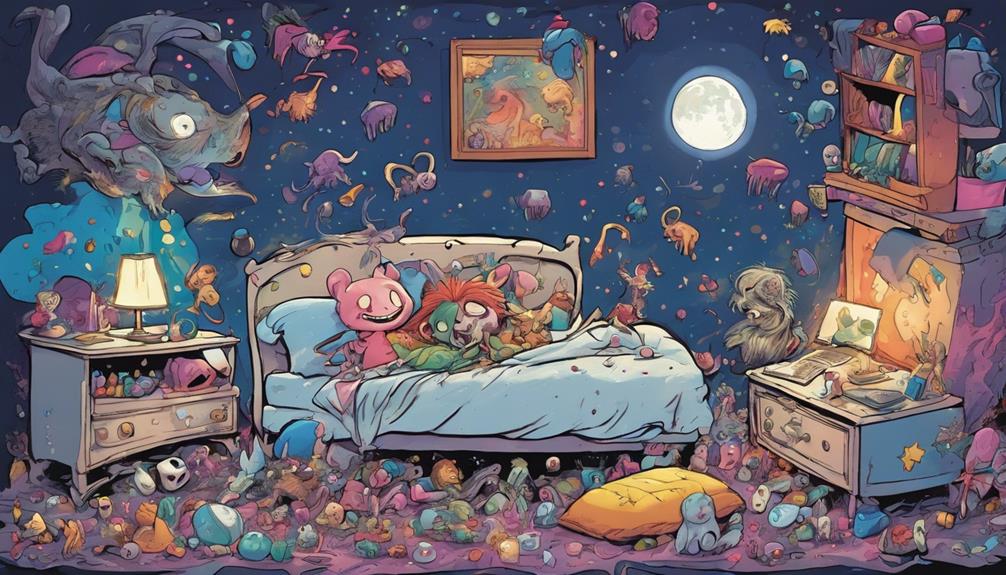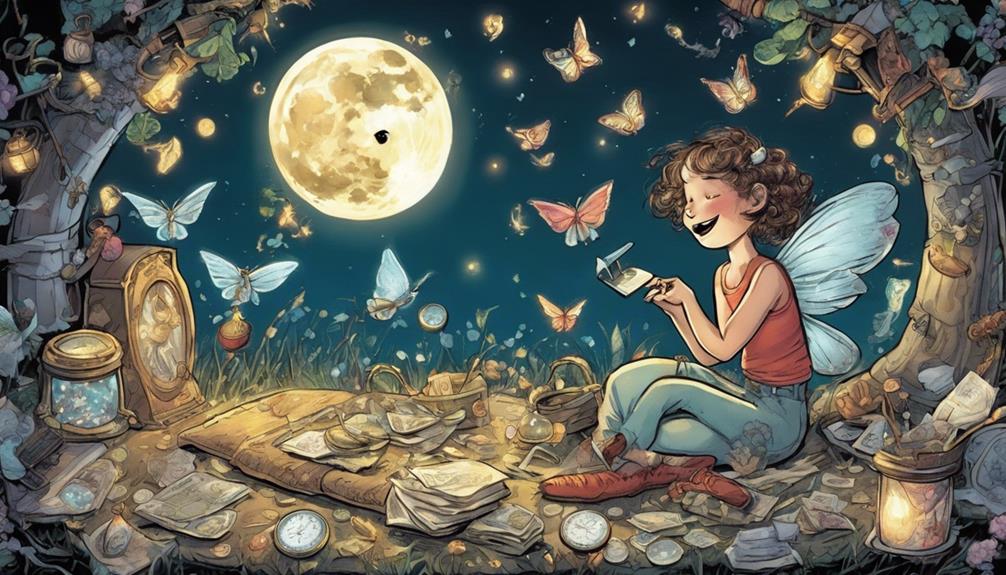The Tooth Fairy may seem friendly, but there's a dark side lurking beneath your pillow. This figure originates from ancient rituals tied to protecting children from witch curses when teeth are improperly disposed of. Different cultures have variations, like the Tooth Mouse, sharing similar beliefs about lost teeth. You might be surprised to learn that hidden under your pillow, the Tooth Fairy doesn't just collect teeth for fun; there's an entire system that categorizes and transforms these teeth into glittering dust or unique treasures. Uncovering these secrets reveals how this charming tradition masks deeper, more complex histories.
Key Takeaways
- The Tooth Fairy's origins are rooted in Dark Ages fears of witch curses linked to improper tooth disposal practices.
- Rituals surrounding tooth disposal often masked deeper societal fears and beliefs about health and protection.
- The transformation of collected teeth into magical fairy dust reflects a whimsical cover for historical anxieties surrounding dental loss.
- The monetary reward offered by the Tooth Fairy has evolved, moving away from traditional practices to reflect modern values.
The Origin of the Tooth Fairy

The Tooth Fairy's origins date back to the Dark Ages, when people believed that properly disposing of lost teeth was crucial to ward off witch curses. During this time, the customs of swallowing, burying, or burning baby teeth emerged to guarantee safety and well-being.
In Northern Europe, early writings recorded the tradition of offering a tand-fé or tooth fee for a child's first lost tooth, emphasizing the cultural significance of these tiny treasures.
Vikings believed that baby teeth held immense value; warriors often wore them as good luck charms. This practice showcased how society revered these small remnants of childhood.
As folklore evolved, so did the characters associated with lost teeth. In eighteenth-century France, the story of La Bonne Petite Souris emerged, a mouse who transformed into a fairy to aid a wrongfully imprisoned queen. This tale contributed to the modern narrative of the Tooth Fairy you know today.
Over centuries, these origins reflect the importance of tooth disposal in various cultures. Each custom highlights humanity's deep-seated belief in safeguarding children's safety, linking the act of losing a tooth to a blend of superstition and celebration.
Cultural Traditions and Variations

Across the globe, diverse cultural traditions and variations celebrate the loss of baby teeth, each adding a unique twist to the enchanting tale of the Tooth Fairy.
In Spain, for instance, children anticipate the arrival of Ratoncito Pérez, a small mouse who collects lost teeth, while in some Latin American countries, the Tooth Mouse plays a similar role. Scandinavian customs often involve giving money for children's teeth, linking the exchange to dental health and future prosperity.
In Viking culture, lost teeth symbolized good fortune, leading to practices where children received payment, and their teeth were worn by warriors as talismans in battle. Eighteenth-century France introduced La Bonne Petite Souris, a mouse that transformed into a fairy, shaping the modern Tooth Fairy narrative. Various regions celebrate tooth loss with rituals like burying teeth, hoping to promote healthy adult teeth.
These cultural traditions highlight the magical part of losing teeth, reinforcing the importance of this childhood milestone. Each custom showcases how different societies view the simple act of losing teeth, transforming it into a memorable experience for children everywhere.
The Tooth Fairy's Hidden Secrets

Revealing the Tooth Fairy's hidden secrets reveals a world of enchantment and mystery surrounding the collection and transformation of children's lost teeth. You mightn't realize that this whimsical figure operates in a domain filled with peculiar practices and traditions from around the globe.
Special bags are designed to dry and prepare children's teeth for their final destination in her magical domain. An inventory system categorizes teeth by the child's name, age, and dental condition. Additionally, the collected teeth are transformed into glittering fairy dust or unique decorations for her hidden castle.
As you place your tooth under the pillow, remember that the money reward you receive—averaging around $3.19 in the U.S.—is just a glimpse into the Tooth Fairy's complex operations. She balances the enchantment of childhood with the practicalities of collecting and processing these precious tokens.
While you might think of her as a sweet figure, she guards hidden secrets that connect with global traditions, from the Tooth Mouse in Spain to various customs in other cultures. The magic of the Tooth Fairy is as intricate as it's delightful.
Myths and Truths Revealed

Delving into the myths surrounding the Tooth Fairy uncovers surprising truths about cultural beliefs and practices that have shaped this enchanting figure over centuries.
The Tooth Fairy myth often masks deeper cultural rituals linked to losing teeth. In the Dark Ages, improperly disposed teeth were believed to invite witch curses, reflecting the fears of that era. Meanwhile, Vikings valued children's lost teeth as good luck charms, with warriors wearing them for protection in battle.
Eighteenth-century French folklore introduced figures like La Bonne Petite Souris, blending the Tooth Fairy narrative with themes of justice and transformation. This evolution showcases how myths adapt over time, influencing our current perceptions.
Today, the average monetary reward for a lost tooth is about $3.19, indicating a shift away from the tradition's financial incentives.
Importantly, the Tooth Fairy serves as a cultural ritual that symbolizes milestones in children's lives. It fosters family bonding while also encouraging important conversations about oral hygiene during these events.
Keeping the Magic Alive

To keep the magic of the Tooth Fairy alive, parents can craft unique rituals that spark excitement and wonder in their children. The Tooth Fairy always leaves behind a little something special, making each experience memorable. Here are some ideas to enhance the tradition:
- Personalized notes from the Tooth Fairy, expressing joy over your child's first tooth.
- Glittery coins or small gifts, wrapped in fairy dust, to create a sense of enchantment.
Engaging your child in conversations about the Tooth Fairy helps them express their beliefs and feelings, while also maintaining the magic. Celebrating milestones like losing that first tooth becomes a cherished family bonding experience.
By sharing tips and creative ideas with others, you can foster a sense of community and discover innovative ways to enrich your children's lives.
Remember, keeping the magic alive isn't just about the money or gifts; it's about creating lasting memories and reinforcing the wonder that comes with growing up.
Frequently Asked Questions
What Is the Dark Story Behind the Tooth Fairy?
You might not realize the Tooth Fairy's origins involve darker themes, like superstitions surrounding lost teeth and historical practices aimed at protecting children from curses. Those beliefs shaped a more sinister narrative beneath her whimsical facade. In some cultures, it was believed that witches could use lost teeth to control or curse a child, leading to rituals designed to destroy or hide them. Over time, these fears transformed into stories of a benevolent figure who would take the teeth away, ensuring their safety and protecting children from harm. Thus, the tooth fairy’s ultimate triumph lies in her evolution from a symbol of fear to one of comfort and magic, embodying hope rather than dread.
What Does the Tooth Fairy Leave Under Your Pillow?
The Tooth Fairy usually leaves money or small gifts under your pillow, creating a magical experience. You might find a shiny coin, a few dollars, or a special toy, making losing a tooth exciting.
How to Put Tooth Fairy Money Under Pillow?
When you're slipping Tooth Fairy money under the pillow, make it a stealthy operation. Wait until the kids are sound asleep, use a cute envelope, and maybe leave a charming note to enhance the magic!
What Is the Tooth Fairy Pillow Story?
The Tooth Fairy Pillow story celebrates the excitement of losing a tooth. You place your tooth in a special pillow, anticipating a magical visit, and wake up to find a surprise gift waiting for you.
Conclusion
As you tuck your child in, remember the tooth fairy isn't just a whimsical figure; she's a keeper of secrets, much like a hidden treasure chest.
While the magic of losing teeth remains enchanting, it's important to reveal the myths surrounding her.
By understanding the tales and traditions, you can enrich the experience and keep the magic alive for generations.
So, next time a tooth slips from their grasp, embrace the wonder while knowing the truth behind the fairy's charm.









